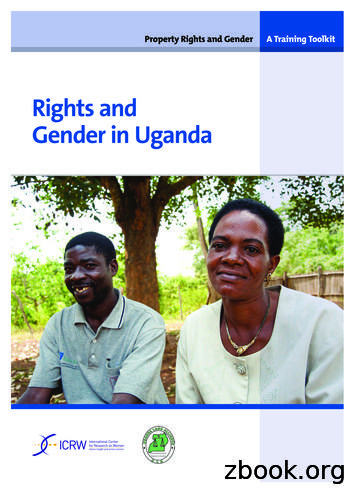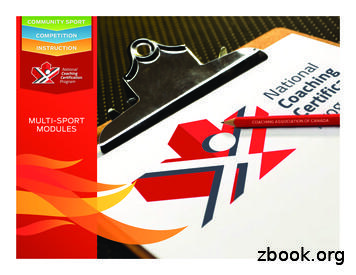Children's Rights In Sport Provisions On Children's SPort
Children’s Rights in SportProvisions on Children’s SportConsidered by the General Assembly on 11–13 May 2007.Adopted changes incorporated and approved by the Executive Board on 28 August 2007.NORWEGIAN OLYMPIC AND PARALYMPIC COMMITTEE AND CONFEDERATION OF SPORTS (NIF)
Children’s Rights in Sportand Provisions on Children’s SportChildren are engaged in sports because theyThe rights and provisions are closely linkedenjoy it. Together with their friends they have togetherexperiences and learn lessons that will last themThe rights constitute a political policya lifetime. This is the foundation that all coaches,instrument which expresses the values whichmanagers and parents must safeguard andwe would like to be the foundation for children’sdevelop further.sport in Norway.Children’s Rights in Sport and Provisions onThe provisions are absolute rules which must beChildren’s Sport are means to ensure the bestcomplied with, obeyed and enforced in sports.possible unified organisation of children’s sportin Norway. The objective is to contribute toIt is important to view the rights and theensure:provisions as closely linked together. The sport activities are organised accordingLocal and/or regional variations are notto the children’s needs and that all children acceptableare included in the sports clubs regardless ofEstablishment of separate provisions ortheir ambitions and needs.guidelines in local or regional parts of the Activities are offered without any differentialmember organisation will not be permitted. Thetreatment and without regard for the child’sprovisions and the rights must be presentedand its parents’ gender, ethnic background,in their entirety as adopted by the Generalfaith, sexual orientation, physicalAssembly.development and disabilities. The sports clubs develop a wide and diverserange of activities and schemes. Coaches, managers and parents become evenbetter at cooperating on facilitating activitiesfor children. Good communication between the varioussports, the parents and the community onwhich values Norwegian children’s sport shallbe based on.There shall be no exemptions from the provisions.
Children’sRights in Sportwith plan for developmentChildren’s sport constitutes sport activitiesfor children up until the year they turn 12years of age. The Children’s Rights in Sportapply to all children without any differentialtreatment and without regard for the child’s andits parents’ gender, ethnic background, faith,sexual orientation, physical development anddisabilities.1. Safety and securityChildren have the right to participate in a safeand secure training environment without anyinappropriate pressure or exploitation. Injuriesmust be prevented. Children under the age of6 must be accompanied by an adult during the4. MasteryChildren have the right to experience a sense ofmastery and to learn many different skills. Theymust also be granted opportunities for variation,training and interaction with others.5. InfluenceChildren have the right to state their viewpointsand to be heard. They must be grantedopportunities to participate in planning andexecution of their own sport activities along withcoaches and parents.6. Freedom to chooseChildren have the right to choose which sport, orhow many sports, they would like to participatein – and decide for themselves how much theywould like to train.7. Competitions for everyone*activities.Children have the right to choose whether or not2. Friendship and well-beingand be granted equal opportunities to participate.Children have the right to participate in trainingand competitive activities which will facilitatedevelopment of friendship and solidarity. A senseof well-being facilitates learning and learningthey would like to participate in competitions,Children transferring from one club toanother within the same sport have the right toparticipate in competitions for the new club assoon as the transfer has been registered.facilitates a sense of well-being.3. Based on the children’s needsChildren have the right to participate in trainingand competitive activities adapted to their age,* NIF would like to point out the importance of viewing Sectionphysical development and level of maturity.7 of the Children’s Rights in Sport within the context of thecompetitive practice for the various types of sports. Section 7stipulates that: «Children have the right to choose whether or notthey would like to participate in competitions, and be grantedequal opportunities to participate». This entails that children whodo not wish to participate in competitions shall also have trainingopportunities on equal terms with others.
Development plan:Follow-up and enforcementEveryone involved in children’s sport shouldThe rights constitute a political policy instrumentfollow a common development plan to ensureto safeguard the children’s rights as individualsthe children have as much variation and as manyand active athletes. This entails obligations foropportunities for experiencing a wide range ofparties other than the children themselves. Themovements as possible. The training plans andchildren are entitled to compliance with thesethe coaches’ practice within the individual sportsrights, and coaches, managers, parents and theshould follow this development plan:organisations themselves must follow up this inpractice.Up to the age of 6Play and varied activities to stimulate theAn example of a violation of these rights is if achildren’s development and basic movements.child is pressured by the parents to participatein competitions against its will. Cf. Section 7 in7–10 years of agethe Children’s Rights states: «Children have theGood opportunities for exploration of andright to choose whether or not they would like totraining within different physical activities orparticipate in competitions».sports with different movement patterns in orderto experience a wide range of movements. ThisThe rights should be used as a reference inwill provide a good foundation for subsequentthe dialogue between the children, coaches,movement training. This may involve one ormanagers and parents.several sports, but each sport is responsiblefor providing varied activities adapted to theIn the event the coaches or the sports clubschildren’s level of development.do not resolve violations of these rights, thenext higher level in the organisation (regional10–12 years of agesporting bodies, national sport federations or theThe sport shall be characterised by a varied andNorwegian Olympic and Paralympic Committeehigh level of activity which will ensure goodand Confederation of Sports) shall be contacted.fundamental skills. An in-depth focus on one ora few sports may ensure a good foundation oftechniques for subsequent development withinthe sport.
Provisions onChildren’s Sport1 Children’s sport constitutes sport activities forchildren up to and including the year they turn12 years of age.2 The following apply for children’s sportcompetitions:a) Children may participate in localcompetitions and sporting events as of theyear they turn 6, primarily within their ownclub.b) Lists of results, tables and rankings may beused in competitions for children as of theyear they turn 11, if this is appropriate.c) Children may participate in regionalcompetitions and sporting events as of theyear they turn 11.d) Children may participate in open* sportingevents in Norway, the Nordic countries andNorthern Scandinavia as of the year theyh) National sport federations which organiseturn 11**.children’s sport shall appoint a boardmember responsible for the children’se) Children from the Nordic countries andsport*****.Northern Scandinavia may participate incompetitions and in sporting events inNorway as of the year they turn 11***.* Open sporting events: No qualification required** Northern Scandinavia comprises Sweden, Finland and Norway. Thisalso covers cooperation within the Barents Region (which also includesf ) All children shall receive a prize if prizes areawarded during a sporting event.Russia).*** Subsection 2 e) must be viewed in the context of subsection 2d) - asthey apply to the same sporting events**** And corresponding national and international championships /g) Children cannot participate inchampionships such as NC, EC and WC upto and including the year they turn 12****.cups.***** This only applies to clubs for a single sport, but it is also recommended for multi-sports clubs. The board of the club may appoint thismember.
Follow-up and enforcementEach national sport federation is responsible forelaborating on the provisions based on the natureand distinctive character of its sport. An exampleof this may be to define what constitute local andregional competitions. However, this must bebased on the intention behind and contents of therights as well as compliance with the age limitsstipulated in the provisions. Such an elaborationmust be based on the consideration for the bestinterest of the children.It is the hope of NIF that violations will beresolved through information and dialoguewithin the individual sports club. If thiscannot be resolved at the lowest level withinthe organisation, the next higher level in theorganisation must be contacted. In the event ofgross violations of the provisions, the relevantlevel in the organisation may consider lodginga formal complaint regarding the matter underSection 11-2 – Acts/omissions subject to penalmeasures – of NIF’s statutes. If so, the complaintmust be submitted to NIF’s AdjudicationCommittee.
For more informationwww.idrett.noSports insurance for childrenAll children who are members of a club associatedwith NIF are insured by the insurance companyif.Do you have any questions?Call 02400 or visit us at www.if.no
Foto: AkillesJoyCommunityHealthHonestyadresse Sognsveien 73 0855 Oslo postadresse 0840 Oslo tlf 47 21 02 90 00www.idrett.no e-post nif-post@idrettsforbundet.no
Children's sport 1 Children's sport constitutes sport activities for children up to and including the year they turn 12 years of age. 2 The following apply for children's sport competitions: a) Children may participate in local competitions and sporting events as of the year they turn 6, primarily within their own club.
EU SPORT POLICY: EVOLUTION EU SPORT POLICY: EVOLUTION 2011: THE COUNCIL WORK PLAN ON SPORT On May 20, the EU Sport Ministers adopted a Work Plan for Sport. The Council Work Plan sets out the sport ministers' priorities in the field of sport for the next three years (2011-2014) and creates new working structures.
Rights and gendeR in Uganda · 3 Rights & Human Rights Background Rights The law is based on the notion of rights. Community rights workers need to understand what rights are, where rights come from, and their own role in protecting and promoting rights. Community rights worker
320i SE 320i M Sport 325i SE 325i M Sport 330i SE 330i M Sport 335i SE 335i M Sport 320d SE 320d M Sport 325d SE 325d M Sport 330d SE 330d M Sport price iNTEriOr TriMS Satin Silver 4CG - - - - - - - Std Dark Aluminium glacier Silver 4WA - - - - - - - Std Black, High-gloss 4AT
1. Sport psychology – Sport practice: Sport psychology is faced with issues that arise from exercise and sport practice. It tries to better understand these demands and attempts to give assistance in satisfying them. 2. Sport psychology – Psychology: Sport psychology is
Canadian Sport Policy that acknowledges the existence of barriers to sport participation for Aboriginal Peoples and has as a goal to increase access and equity in sport. In 2003, the federal govern ment modernized its sport legislation with the passing of the Physical Activity and Sport Act. This Act confirmed the Govern
apply a school sport philosophy and the NCCP Code of Ethics to your school sport pro-gram; integrate safety standards into school sport coaching; manage school sport policies and procedures; and apply the roles and responsibilities of a school sport coach. This workshop is delivered by the following School Sport Oganizations in .
through an online national Children’s Rights Poll and consulted in person with approximately 450 children. Through talking to children about human rights, and their rights in particular, it is clear that rights knowledge strengthens children’s agency and capabilities, and also engenders respect for the rights of others.
TCIA (ASC A300) (Tree Care Industry Association) Revision BSR A300 Part 2-201x, Tree, Shrub, and Other Woody Plant Management - Standard Practices (Soil Management a. Assessment, b. Modification, c. Fertilization, and d. Drainage) (revision of ANSI A300 Part 2-2011) A300 (Part 2) Soil Management standards are performance standards for























